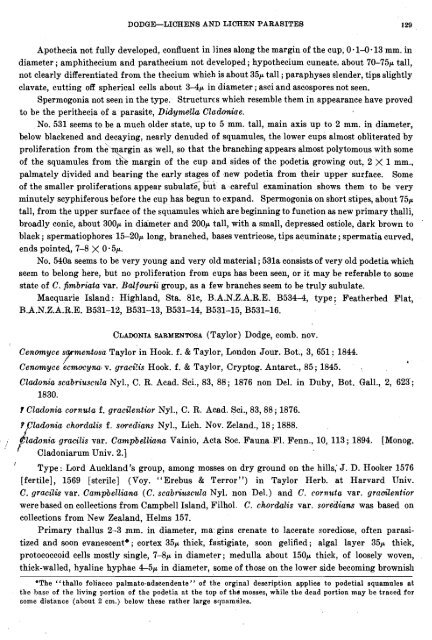Create successful ePaper yourself
Turn your PDF publications into a flip-book with our unique Google optimized e-Paper software.
DODGE--<strong><strong>LICHEN</strong>S</strong> <strong>AND</strong> <strong>LICHEN</strong> <strong>PARASITES</strong> 129<br />
Apothecia not fully developed, confluent in lines along the margin of the cup, 0.1--0.13 mm. in<br />
diameter ; amphithecium and parathecium not developed ; hypothecium cuneate, about 70-75r, tall,<br />
not clearly differentiated from the thecium which is about 35p tall ; paraphyses slender, tips slightly<br />
clavate, cutting off spherical cells about 34r, in diameter ; asci and ascospores not seen.<br />
Spermogonia not seen in the type. Structures which resemble them in appearance have proved<br />
to be the perithecia of a parasite, DidynzeUa Clafiae.<br />
No. 531 seems to be a much older state, up to 5 mm. tall, main axis up to 2 mm. in diameter,<br />
below blackened and decaying, nearly denuded of squamules, the lower cups almost obliterated by<br />
proliferation from theyargin as well, so that the branching appears almost polytomous with some<br />
of the squamules from tl;'e margin of the cup and sides of the podetia growing out, 2 X 1 mm.,<br />
palmately divided and bearing the early stages of new podetia from their upper surface. Some<br />
of the smaller proliferations appear subul6 but a careful examination shows them to be very<br />
minutely scyphiferous before the cup has begun to expand. Spermogonia on short stipes, about 75/*<br />
tall, from the upper surface of the sqnamules which are beginning to function as new primary thalli,<br />
broadly conic, about 300p in diameter and 20OP tall, with a small, depressed ostiole, dark brown to<br />
black ; spermatiophores 15-20p long, branched, bases ventricose, tips acuminate ; spermatia curved,<br />
ends pointed, 7-8 X 0 - 5p.<br />
No. 540a seems to be very young and very old material ; 531a consists of very old podetia which<br />
seem to belong here, but no proliferation from cups has been seen, or it may be referable to some<br />
state of C. fimbriata var. Bdfourii group, as a few branches seem to be truly subulate.<br />
Macquarie Island : Highland, Sta. 81c, B.A.N.Z.A.R.E. B534-4, type ; Featherbed Flat,<br />
R.A.N.Z.A.R.E. B531-12, B531-13, B531-14, B531-15, B531-16.<br />
CLAD~NIA SARMEN~OSA (Taylor) Dodge, comb. nov.<br />
Cenomyce sqmentosa Taylor in Hook. f. & Taylor, London Jour. Bot., 3, 651 : 1844.<br />
I<br />
Cenomyce ;cmocym v. graci!is Hook. f. & Taylor, Cryptog. Antarct., 85; 1845.<br />
Cladonia scabriuscwla Nyl., C. R. Acad. Sci., 83, 88; 1876 non Del. in Duby, Bot. Gall., 2, 623;<br />
1830.<br />
? Cladonia cornuia f. gracilentior Nyl., C. R. Acad. Sci., 83, 88 ; 1876.<br />
?,Cladonia chordalis f. soredians Nyl., Lich. Nov. Zeland., 18; 1888.<br />
I<br />
:' ):<br />
d'ladonia gracilis var. Ca.mpbelliuna Vainio, Acta Soc. Fauna-F1. Fenn., 10, 113; 1894. [Monog.<br />
Cladoniarum Univ. 2.1<br />
1<br />
Type : Lord Auclrland's group, among mosses on dry ground on the hills,. J. D. Hoolrer 1576<br />
[fertile], 1569 [sterile] (Voy. "Erebus & Terror") in Taylor Herb. at Harvard TJniv.<br />
C. gracilis var. Campbelliana (C. scabriwczda Nyl. non Del.) and C. cornuta var. gradentior<br />
were based on collections from Campbell Island, Filhol C. chordalis var. soredians was based on<br />
collections from New Zealand, Helms 157.<br />
Primary thallus 2-3 mm. in diameter, ma-gins crenate to lacerate ~orediose, often parasi-<br />
tized and soon evanescent*; cortex 35r, thick, fastigiate, soon gelified; algal layer 35p thick,<br />
protococcoid cells mostly single, 7-8p in diameter ; medulla about 15OP thiclr, of loosely woven,<br />
thick-walled, hyaline hyphae 4-5/* in diameter, some of those on the lower side becoming brownisli<br />
*The "thallo foliaceo palmato-adscendente" of the orginal description applies to podetial squamules at<br />
thc base of the living portion of the podetia at the top of th6 mosses, while the dead portion may be traced for<br />
some distance (about 2 cm.) below these rather large squamdles.<br />
1

















